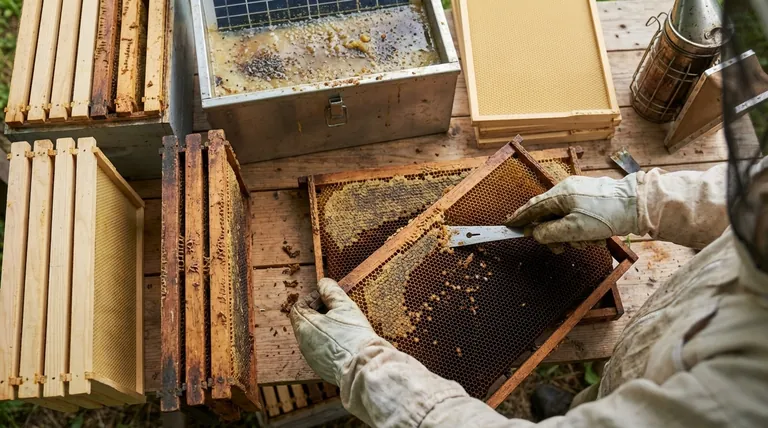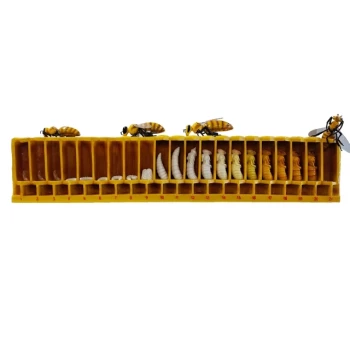Yes, you can absolutely reuse bee foundation. Reusing foundation is a common and highly effective practice among beekeepers to save resources and give colonies a significant head start. The method you choose—either cleaning the existing comb for direct reuse or melting the wax for recycling—depends entirely on the age, condition, and health history of the frames.
Reusing foundation is a strategic decision that trades convenience for potential risks. While it saves bees immense energy and speeds up honey production, you must first ensure the old comb is free from disease and pests to protect the health of your colony.

Why Reuse Foundation in the First Place?
Understanding the benefits helps clarify why this is such a valuable practice in apiary management. It saves significant resources for both the bees and the beekeeper.
The Energy Advantage for Bees
Producing beeswax is one of the most energy-intensive tasks a honeybee performs. It is estimated that bees consume 6-8 pounds of honey to produce just one pound of wax.
By providing drawn comb, you allow the colony to bypass this enormous effort. They can immediately begin storing nectar, pollen, or raising brood.
Faster Honey Production
A colony given drawn comb on foundation will fill it with honey much faster than one that must build comb from scratch. During a strong nectar flow, this can be the difference between a surplus honey harvest and a colony merely building up its infrastructure.
Cost and Time Savings
For the beekeeper, foundation and frames represent a recurring cost. Reusing frames saves money and the time it takes to assemble and install new foundation.
Assessing Your Frames for Reuse
Not all frames are suitable for reuse. A careful inspection is the most critical step in this process.
The Ideal Candidate: Lightly Drawn, Healthy Comb
Frames that were used for one season, are light in color, and come from a strong, disease-free hive are perfect for direct reuse. The comb should be straight and largely free of drone cells or damage.
These frames can often be placed directly back into a hive for the bees to clean up and utilize.
When to Scrape and Clean
If a frame has some crystallized honey, pollen, or a few stray burr combs, but the foundation itself is in good shape, a simple cleaning is sufficient.
Use a hive tool to gently scrape away debris. A strong colony will quickly repair and polish a cleaned frame, turning it into a perfect comb within weeks.
When to Melt Down and Recycle
Old frames that are black with age, contain excessive drone comb, or show signs of wax moth damage should not be put back in a hive. The wax, however, is still a valuable resource.
You can cut the old comb from the frame and use a solar or steam wax melter to render it. This recycled beeswax can be filtered and made into new foundation, candles, or other products.
Understanding the Trade-offs and Risks
Reusing foundation is not without potential downsides. Awareness of these risks is essential for responsible beekeeping.
The Critical Risk of Disease
This is the most significant danger. Pathogens, especially the spores that cause American Foulbrood (AFB), can persist in old comb for decades.
Never reuse any equipment from a hive that has died from or shown signs of AFB. Such frames must be burned or properly destroyed to prevent a catastrophic spread of the disease.
Pest Contamination
Old, stored comb is a prime target for wax moths and hive beetles. Their eggs and larvae can hide in the cells.
Freezing your frames for at least 48 hours before storage or reuse is an effective way to kill any pests and their eggs that may be present.
Chemical and Pesticide Buildup
Beeswax acts like a sponge, absorbing agricultural pesticides and in-hive mite treatments over time. After several years, these residues can build up to levels that may harm the colony's health.
For this reason, many beekeepers systematically rotate out their oldest frames (every 3-5 years) regardless of their physical condition.
Making the Right Choice for Your Frames
Your decision should be based on a clear assessment of the frame's condition and your primary goal for the colony.
- If your frames are 1-2 years old and from a healthy hive: Your best option is to scrape them clean and reuse them directly to give your bees a powerful head start.
- If your frames are old, dark, or damaged: Prioritize colony health by cutting out the comb and melting it down to recycle the clean beeswax.
- If you have any suspicion of serious disease: The only safe choice is to destroy the frames completely to protect the rest of your apiary.
By thoughtfully managing your frames, you harness a powerful resource that promotes healthier bees and more productive hives.
Summary Table:
| Frame Condition | Recommended Action | Key Benefit |
|---|---|---|
| Lightly Drawn, Healthy Comb | Clean & Reuse Directly | Gives bees a head start, saves energy |
| Old, Dark, or Damaged Comb | Melt Down & Recycle Wax | Recycles valuable wax, prevents disease risk |
| Suspected Disease (e.g., AFB) | Destroy Frames Completely | Protects entire apiary from contamination |
Optimize your apiary's efficiency with HONESTBEE's reliable supplies. Reusing foundation is a smart strategy, and having the right equipment is key. HONESTBEE supplies commercial apiaries and beekeeping equipment distributors with high-quality, durable beekeeping supplies through our wholesale-focused operations. Ensure your frames and foundations are built to last. Contact our experts today to discuss your wholesale needs and build a healthier, more productive operation.
Visual Guide

Related Products
- Notebook Style Beeswax Foundation Mould Wax Foundation Mold
- Food Grade Plastic bee Foundation for Bee Frames
- Electric Flatting and Embossing Machine with Tray for Beekeeping
- Electric Beeswax Foundation Machine With Operating Tray and Wax Foundation Roller
- Electric Beeswax Flat Sheet Machine with Operating Tray for Wax Processing
People Also Ask
- What is the process for making beeswax sheets using a mold? A Step-by-Step Guide for Perfect Results
- What are the uses of recycled beeswax cappings? Transform Honey Byproducts into Valuable Assets
- Can beeswax foundation be recycled or reused? A Guide to Sustainable Beekeeping
- What is beeswax foundation made of? A Guide to Stronger, More Efficient Hives
- How is beeswax foundation installed and what are its characteristics? Boost Hive Health Naturally



















